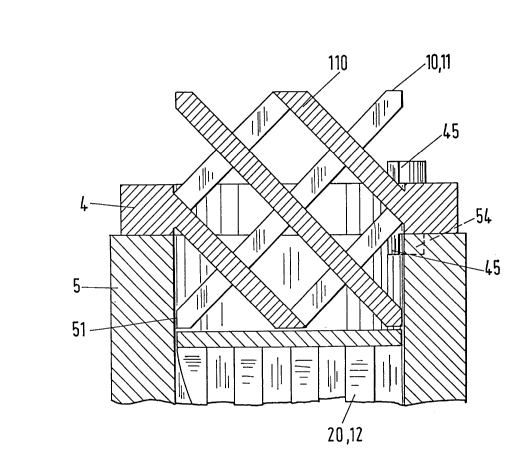Une partie des informations de ce site Web a été fournie par des sources externes. Le gouvernement du Canada n'assume aucune responsabilité concernant la précision, l'actualité ou la fiabilité des informations fournies par les sources externes. Les utilisateurs qui désirent employer cette information devraient consulter directement la source des informations. Le contenu fourni par les sources externes n'est pas assujetti aux exigences sur les langues officielles, la protection des renseignements personnels et l'accessibilité.
L'apparition de différences dans le texte et l'image des Revendications et de l'Abrégé dépend du moment auquel le document est publié. Les textes des Revendications et de l'Abrégé sont affichés :
| (12) Brevet: | (11) CA 2150817 |
|---|---|
| (54) Titre français: | DISPOSITIF D'HOMOGENEISATION DE FLUIDES TRES VISQUEUX |
| (54) Titre anglais: | DEVICE FOR HOMOGENISING HIGHLY VISCOUS FLUIDS |
| Statut: | Réputé périmé |
| (51) Classification internationale des brevets (CIB): |
|
|---|---|
| (72) Inventeurs : |
|
| (73) Titulaires : |
|
| (71) Demandeurs : | |
| (74) Agent: | GOWLING WLG (CANADA) LLP |
| (74) Co-agent: | |
| (45) Délivré: | 1997-07-01 |
| (86) Date de dépôt PCT: | 1994-09-30 |
| (87) Mise à la disponibilité du public: | 1995-04-13 |
| Requête d'examen: | 1995-06-01 |
| Licence disponible: | S.O. |
| (25) Langue des documents déposés: | Anglais |
| Traité de coopération en matière de brevets (PCT): | Oui |
|---|---|
| (86) Numéro de la demande PCT: | PCT/CH1994/000195 |
| (87) Numéro de publication internationale PCT: | WO1995/009689 |
| (85) Entrée nationale: | 1995-06-01 |
| (30) Données de priorité de la demande: | ||||||
|---|---|---|---|---|---|---|
|
Un dispositif d'homogénéisation de fluides très visqueux comprend des mélangeurs statiques (11, 12) et, le cas échéant, des éléments de filtrage (6). Ces éléments constitutifs du dispositif sont montés dans une douille (13) le long de l'axe (15) de la douille. La douille est constituée de plusieurs parties et les éléments constitutifs du dispositif forment des composants monolithiques (10, 20; 60). Plusieurs ou tous ces composants ont des parties (4; 4a, 4b) similaires à des rebords ou à des becs. Les composants sont ancrés dans la zone de la douille située entre les parties de la douille par ces parties similaires à des rebords ou à des becs et constituent en même temps des parties de la douille. Ce dispositif est utilisé par exemple comme tête mélangeuse (1) dans la filière d'une machine à couler par injection ou comme mélangeur de la masse fondue dans une extrudeuse.
A device for homogenising highly viscous fluids has static mixing elements
(11, 12) and if required filtering elements (6). These elements of the device
are arranged in a sleeve (13) along the axis (15) of the sleeve. The sleeve is
made of several parts and the elements that make up the device are monolithic
components (10, 20; 60). Many or all components have flange- or nose-like
parts (4; 4a, 4b) with which they are anchored in the area of the sleeve
located between the parts that make up the sleeve and at the same time form
parts of the sleeve. This device is suitable for example as mixing head (1) in
the nozzle of an injection casting machine or as molten mass mixer in an
extruder.
Note : Les revendications sont présentées dans la langue officielle dans laquelle elles ont été soumises.
Note : Les descriptions sont présentées dans la langue officielle dans laquelle elles ont été soumises.

Pour une meilleure compréhension de l'état de la demande ou brevet qui figure sur cette page, la rubrique Mise en garde , et les descriptions de Brevet , États administratifs , Taxes périodiques et Historique des paiements devraient être consultées.
| Titre | Date |
|---|---|
| Date de délivrance prévu | 1997-07-01 |
| (86) Date de dépôt PCT | 1994-09-30 |
| (87) Date de publication PCT | 1995-04-13 |
| (85) Entrée nationale | 1995-06-01 |
| Requête d'examen | 1995-06-01 |
| (45) Délivré | 1997-07-01 |
| Réputé périmé | 2013-10-01 |
Il n'y a pas d'historique d'abandonnement
Les titulaires actuels et antérieures au dossier sont affichés en ordre alphabétique.
| Titulaires actuels au dossier |
|---|
| SULZER CHEMTECH AG |
| Titulaires antérieures au dossier |
|---|
| SIGNER, ARNO |